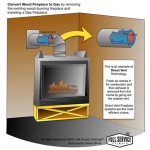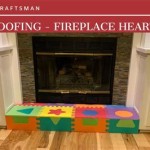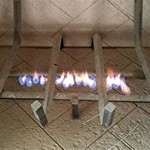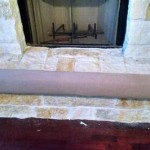Plasma TV on Top of a Gas Fireplace: A Comprehensive Analysis
The integration of modern entertainment systems into living spaces often involves optimizing space utilization and aesthetic appeal. Mounting a plasma television above a gas fireplace is a common design consideration, aiming to consolidate focal points and create a visually cohesive entertainment area. However, this configuration presents a variety of potential challenges and requires careful evaluation to ensure the longevity of the television and the safety of the environment. This article will delve into the potential issues associated with placing a plasma television above a gas fireplace, offering insights into heat management, installation considerations, and alternative solutions.
Plasma televisions, while once a dominant technology in the display market, have been largely superseded by LCD and OLED technologies. However, many households still possess and utilize these devices. Plasma displays generate heat during operation, and the addition of a gas fireplace introduces a secondary heat source. This combined thermal load can have detrimental effects on the television's performance and lifespan.
Understanding the Thermal Risks
Excessive heat is a primary concern when positioning a plasma television above a gas fireplace. Plasma televisions are designed to operate within a specific temperature range, typically outlined in the manufacturer's specifications. Exceeding this range can lead to several problems, including:
Component Degradation: Heat accelerates the degradation of electronic components within the television. Capacitors, resistors, and integrated circuits are particularly vulnerable to thermal stress. Prolonged exposure to elevated temperatures can cause these components to fail prematurely, resulting in image distortion, reduced brightness, or complete device failure.
Screen Damage: The plasma display panel itself is sensitive to heat. Excessive temperatures can lead to discoloration, pixel burnout, or even cracking of the screen. These issues are often irreversible and require costly repairs or complete replacement of the television.
Reduced Lifespan: The overall lifespan of the television is significantly reduced when subjected to consistently high temperatures. The cumulative effect of heat-induced component degradation shortens the period of reliable operation, making the initial aesthetic appeal of the installation a short-lived benefit.
Warranty Voidance: Many television manufacturers explicitly state in their warranty terms that damage caused by excessive heat is not covered. Mounting a television above a heat-generating appliance like a gas fireplace may invalidate the warranty, leaving the owner responsible for any repair or replacement costs.
To mitigate these risks, it is crucial to accurately assess the heat output of the gas fireplace and the temperature sensitivity of the plasma television. This assessment should involve measuring the temperature of the wall above the fireplace during typical operation to determine if it falls within the acceptable range specified by the television manufacturer.
Installation Considerations and Best Practices
If, after careful assessment, the decision is made to proceed with mounting a plasma television above a gas fireplace, several installation considerations become paramount. These considerations aim to minimize heat exposure and ensure the structural integrity of the installation.
Mantel Placement: A substantial mantel extending outward from the wall can act as a heat shield, deflecting rising heat away from the television. The depth and material of the mantel should be carefully chosen to provide effective thermal protection. Non-combustible materials such as stone or concrete are preferable to wood, as they offer greater heat resistance.
Mounting Height: The height at which the television is mounted above the fireplace significantly impacts its exposure to heat. Higher mounting positions generally result in lower temperatures at the television's location. However, excessively high mounting positions can lead to uncomfortable viewing angles and neck strain. A balance must be struck between heat mitigation and ergonomic considerations.
Wall Construction: The type of wall construction supporting the television and fireplace is a crucial factor. If the wall is constructed of combustible materials, such as wood framing, appropriate fire-resistant barriers must be installed to prevent the spread of heat. Consultation with a qualified contractor or building inspector is recommended to ensure compliance with local building codes and safety regulations.
Ventilation: Adequate ventilation behind the television is essential to dissipate any heat that does reach the device. Providing ample space for air to circulate allows for natural convection cooling, reducing the risk of overheating. Avoid completely enclosing the television in a cabinet or recess, as this can trap heat and exacerbate thermal problems.
Professional Installation: Engaging a professional installer with experience in mounting televisions above fireplaces is highly recommended. A qualified installer can assess the specific conditions of the installation, recommend appropriate mounting hardware, and ensure that all safety requirements are met. Furthermore, they can advise on optimal viewing angles and cable management solutions.
Regular Monitoring: After installation, it is essential to regularly monitor the temperature around the television. A simple digital thermometer can be used to measure the surface temperature of the wall and the back of the television during fireplace operation. If excessive temperatures are detected, adjustments to the fireplace settings or the addition of further heat shielding may be necessary.
Exploring Alternative Solutions
Given the inherent risks associated with mounting a plasma television directly above a gas fireplace, exploring alternative solutions is often the most prudent approach. These alternatives aim to separate the television and fireplace, minimizing thermal exposure and optimizing viewing comfort.
Separate Entertainment Center: The most straightforward solution is to position the television on a separate wall or within a dedicated entertainment center away from the fireplace. This arrangement eliminates the risk of heat damage and allows for greater flexibility in terms of viewing angles and audio system placement. While this option may require rearranging the furniture layout, it provides the safest and most reliable solution.
Electric Fireplace Insert: Consider replacing the gas fireplace with an electric fireplace insert. Electric fireplaces produce significantly less heat than gas fireplaces and offer greater control over temperature settings. Some electric fireplaces even feature integrated heaters that can be independently controlled, allowing for aesthetic flame effects without generating excessive heat. This can be a viable option for maintaining the visual appeal of a fireplace while minimizing the thermal risks to the television.
Repositioning the Fireplace: In some cases, it may be possible to reposition the fireplace to a different location in the room. This may involve significant renovation work, but it can provide the ideal solution for separating the heat source from the television. Repositioning the fireplace also opens up new design possibilities for the living space, allowing for a more balanced and aesthetically pleasing arrangement.
Using a Heat Deflector: Specialized heat deflectors are available that are designed to redirect the heat flow away from the television. These deflectors are typically made of metal and are installed above the fireplace opening. While they can be effective in reducing heat exposure, they may also detract from the aesthetic appeal of the fireplace. The effectiveness of a heat deflector depends on the specific design of the fireplace and the size of the deflector.
Lowering the Fireplace: In some designs, the gas fireplace can be lowered closer to the floor. This increases the distance between the fireplace and the television, reducing the amount of heat that reaches the television. This requires significant renovations and may not be possible depending on the existing fireplace design and gas line configurations.
In conclusion, while mounting a plasma television above a gas fireplace may seem like an appealing space-saving solution, the potential risks associated with heat exposure should not be underestimated. Thorough assessment, careful installation practices, and consideration of alternative solutions are crucial for ensuring the longevity of the television and the safety of the environment. Prioritizing safety and practicality over aesthetic considerations is essential when integrating electronic devices with heat-generating appliances.

Can I Mount My Tv Above The Fireplace

Can I Mount A Tv Over My Fireplace Warming Trends

Can I Mount My Tv Above The Fireplace

Can I Put A Tv Above Fireplace The Ultimate Guide Bonfire

Can You Put A Tv Over Fireplace Direct Fireplaces

Cvo Fitting Tv Above Fireplace Installation Gas Fire Lcd Plasma Living Room With Wall Units Home

Can You Put A Tv Over Fireplace Direct Fireplaces
Is Mounting A Tv Over Fireplace Bad Idea Quora

Flat Screen Tv Over Fireplace Designs To Hide Or Not

Can You Install A Tv Above Fireplace Fact Or Fiction








